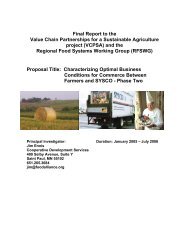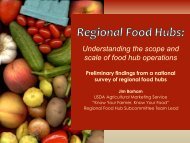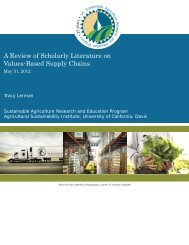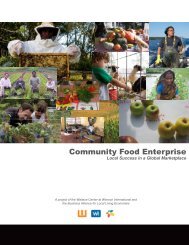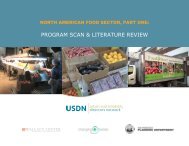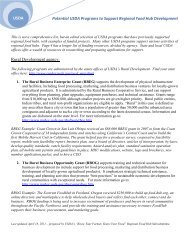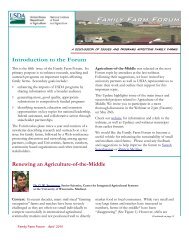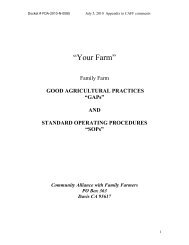The Common Market Feasibility Study - Agricultural Marketing Service
The Common Market Feasibility Study - Agricultural Marketing Service
The Common Market Feasibility Study - Agricultural Marketing Service
You also want an ePaper? Increase the reach of your titles
YUMPU automatically turns print PDFs into web optimized ePapers that Google loves.
THE COMMON MARKET FEASIBILTY STUDYSupply Analysis50Because dairy farmers in the southeastern United States are disappearing at rates faster than inPennsylvania, milk in PA has become an export product. Research was inconclusive in assessing thequantity of milk that stays in PA, versus the quantity that is exported.Milk produced in Pennsylvania for sale through the <strong>Common</strong> <strong>Market</strong> will have characteristics thatdifferentiate it from the conventional marketplace. Milk ideal for serving the <strong>Common</strong> <strong>Market</strong> is• Processed and marketed through independent channels, not the large conventionalmarketplace,• Produced in a “sustainable” manner. Potential examples of sustainable dairy farming includefeeding the cows grass (as opposed to grain), not pasteurizing the milk (known as raw dairy,requiring permits from PA Department of Ag for resale), and omitting growth hormones andunnecessary antibiotics when raising cows.Based on these stipulations, Ag Census data for milk supply to the <strong>Common</strong> <strong>Market</strong> is largely nonapplicable.<strong>The</strong> PSU Ag Map and Fair Food Project Databases indicate 43 small-scale dairy producers inthe 14 county region surrounding Philadelphia. <strong>The</strong>se dairy producers are generally geared towarddirect sales and process their own product. In some cases, these dairy farmers are selling some of theirproduct to larger buyers (Horizon Milk for example) and keeping their highest quality milk for directsales.Since size and quantity of production of these dairy farmers varies greatly and is not statisticallyavailable, supply potential of milk for the <strong>Common</strong> <strong>Market</strong> is largely inconclusive. While it is clear thatvast quantities of milk are produced in Pennsylvania, to serve markets like the <strong>Common</strong> <strong>Market</strong>, it maybe necessary to gear farmers toward more sustainable production or sales channels conducive to theindependent marketplace.ConclusionWithout extensive research, it is difficult to comprehensively calculate the supply potential for the<strong>Common</strong> <strong>Market</strong>. Analysis of agricultural census data demonstrates that Pennsylvania is a nationalleader in agricultural production, particularly in the produce, poultry, beef, and dairy segments.Nonetheless, without research to show the sales channels for these products or account for the quantityof production demanded by the marketplace, supply chain capacity for the <strong>Common</strong> <strong>Market</strong> is largelybased on conjecture.To better support these conjectures and provide a level of significance to help the <strong>Common</strong> <strong>Market</strong>proceed, analysis of the Penn State University (PSU) <strong>Agricultural</strong> (Ag) Map and Fair Food Projectdatabases was applied. <strong>The</strong>se databases contain farmers who fit the general description of farmersmost apt to sell to the <strong>Common</strong> <strong>Market</strong>. While surely not complete lists of possible farmers for the<strong>Common</strong> <strong>Market</strong>, these lists provide some perspective on available supply for the <strong>Common</strong> <strong>Market</strong>.To conclude, ample supply of produce, poultry, beef, and milk are produced in Pennsylvania. To bestunderstand how that supply can be linked to the <strong>Common</strong> <strong>Market</strong>, further, more extensive research isrequired.



